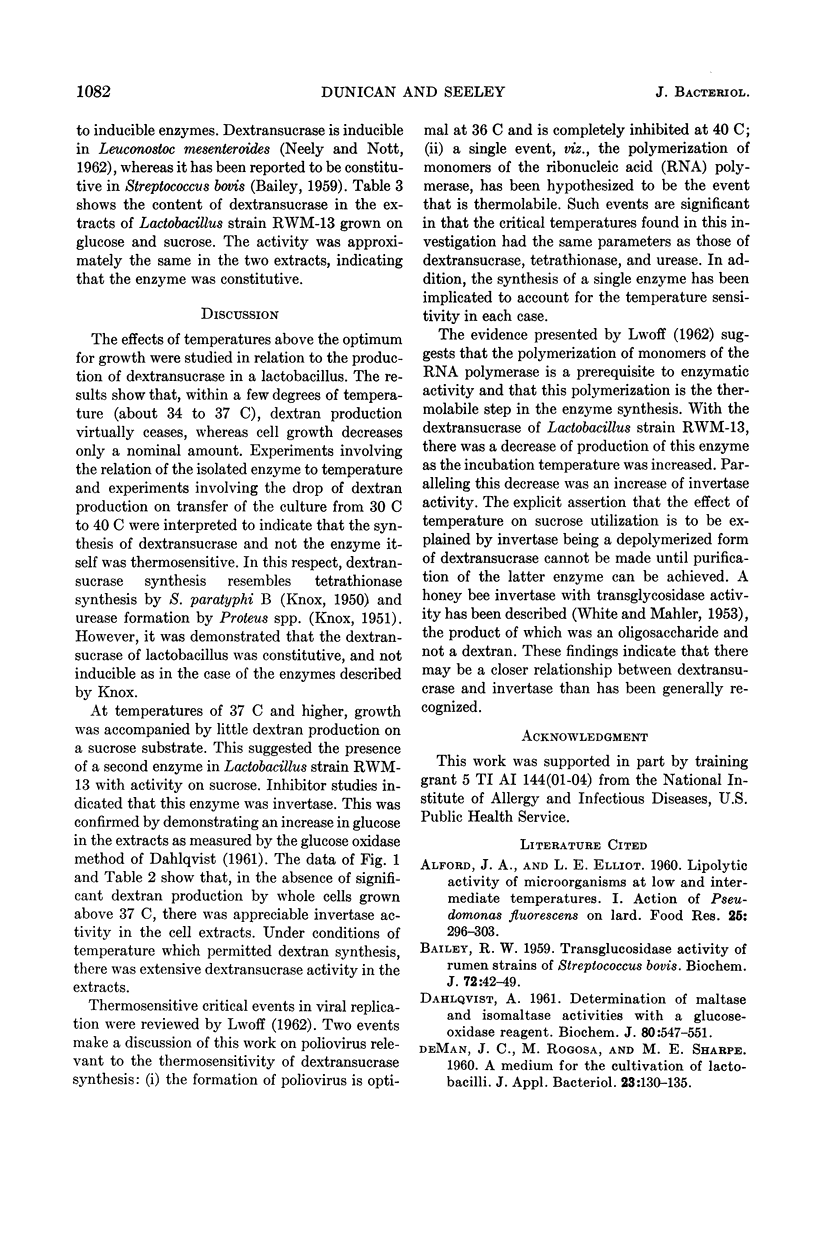Abstract
Dunican, L. K. (Cornell University, Ithaca, New York), and H. W. Seeley, Jr. Temperature-sensitive dextransucrase synthesis by a lactobacillus. J. Bacteriol. 86:1079–1083. 1963.—Dextran synthesis was found to be temperature-dependent in Lactobacillus strain RWM-13. Dextran was not formed above 37 C, although growth of cells occurred up to 42 C. Logarithmically growing cells transferred from 30 C to 40 C ceased producing dextran while growth decreased nominally. An examination of the extracts of cells broken by sonic treatment showed that as the temperature of growth was increased above 37 C the production of dextransucrase decreased. By use of an inhibitor of invertase, 10−4m AgNO3, it was shown that invertase replaced dextransucrase activity at temperatures above 37 C. In contrast to dextransucrase in Leuconostoc mesenteroides, the enzyme in Lactobacillus strain RWM-13 was constitutive and thus resembled that of Streptococcus bovis. Thermosensitivity of dextransucrase synthesis has not been observed in Leuconostoc or Streptococcus.
Full text
PDF




Selected References
These references are in PubMed. This may not be the complete list of references from this article.
- BAILEY R. W. Transglucosidase activity of rumen strains of Streptococcus bovis. 2. Isolation and properties of dextransucrase. Biochem J. 1959 May;72(1):42–49. doi: 10.1042/bj0720042. [DOI] [PMC free article] [PubMed] [Google Scholar]
- DAHLQVIST A. Determination of maltase and isomaltase activities with a glucose-oxidase reagent. Biochem J. 1961 Sep;80:547–551. doi: 10.1042/bj0800547. [DOI] [PMC free article] [PubMed] [Google Scholar]
- GOODMAN A., WEIL R. M., STERN K. G. On the mechanism of dextran formation; chromatographic studies with C14-labeled sugars. J Biol Chem. 1955 Dec;217(2):977–985. [PubMed] [Google Scholar]
- KNOX R. Tetrathionase: the differential effect of temperature on growth and adaptation. J Gen Microbiol. 1950 Sep;4(3):388–392. doi: 10.1099/00221287-4-3-388. [DOI] [PubMed] [Google Scholar]
- LWOFF A. The thermosensitive critical event of the viral cycle. Cold Spring Harb Symp Quant Biol. 1962;27:159–174. doi: 10.1101/sqb.1962.027.001.018. [DOI] [PubMed] [Google Scholar]
- NEELY W. B., NOTT J. Dextransucrase, an induced enzyme from Leuconostoc mesenteroides. Biochemistry. 1962 Nov;1:1136–1140. doi: 10.1021/bi00912a027. [DOI] [PubMed] [Google Scholar]
- UPADHYAY J., STOKES R. L. Temperature-sensitive formic hydrogenlyase in a psychrophilic bacterium. J Bacteriol. 1963 Jan;85:177–185. doi: 10.1128/jb.85.1.177-185.1963. [DOI] [PMC free article] [PubMed] [Google Scholar]
- WHITE J. W., Jr, MAHER J. Transglucosidation by honey invertase. Arch Biochem Biophys. 1953 Feb;42(2):360–367. doi: 10.1016/0003-9861(53)90365-8. [DOI] [PubMed] [Google Scholar]


